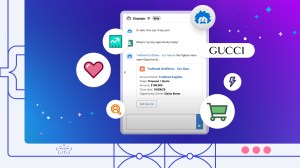Today, MuleSoft announced the next major release of Anypoint Platform, bringing the power of the application network graph to every customer. The application network graph embedded in Anypoint Platform transforms the way organizations can access information about their applications and systems—whether in the cloud or on-premises—and act upon that data in real-time to increase their speed of change and innovation.
We caught up with MuleSoft’s Senior Product Marketing Manager Ahyoung An for her thoughts on Anypoint Platform’s newest features and why integration should be a strategic initiative for every business and technology leader.
What’s new with Anypoint Platform?
With every release, MuleSoft’s goal is to help customers build application networks, which are networks of applications, data and devices connected via APIs to make them reusable and pluggable instead of glued together with custom integration code. The power of the application network lies in its graph, which understands every detail about an organization’s applications, data and devices.
Today, we announced the latest release of Anypoint Platform, which allows any company to use machine learning, get real-time insights and apply advanced security through the application network graph embedded in Anypoint Platform. Lots of information resides within organizations, but being able to access and act upon that data is really the difficult part.
So what we’re doing with the latest release of Anypoint Platform is surfacing valuable insights hidden across the enterprise through new visualizations, recommendations and security measures for customers to really benefit from.
Will you expand on what an application network graph is and why it’s so important for today’s enterprise?
Sure, if you think about social networks back when Facebook first emerged, they were working with very basic information—information about yourself and those you were connected with. But social graphs transformed the way people can access information about each other and the world. For example, using social graphs, Facebook is able to choose the article you read first or recommend books to you based on what a friend liked. The social graph completely changed the level of insights and recommendations users were able to receive.
The same applies to the application network graph, which contains metadata about every detail within an organization’s application network, such as the catalog of APIs that are available, their versions, the developers that are authorized to access those versions, and the apps consuming the APIs. By embedding the application network graph into Anypoint Platform, we’re providing customers with new insights they weren’t privy to before, including which developers and applications are impacted by a deprecation of a specific version of an API or how to map two systems together based on previous mappings from across the application network. Being able to have access to this information, derive insights from it, and take action in real-time will help our customers drive their digital transformation initiatives forward. We’re empowering customers to more easily unlock, visualize and act upon their data.
Can you share how the new features you have added will help a customer pull insights from the data to make better decisions?
The best thing about the latest release of Anypoint Platform is that customers do not have to learn a new query language or do complex custom coding to pull the insights. We have abstracted away the complexity in gathering data across the organization’s applications, data and devices to surface insights through Anypoint Platform.
Within Anypoint Platform, pulling insights is done through Anypoint Visualizer, Anypoint Monitoring, Anypoint Design Center and API policies. With Anypoint Visualizer, customers can build a holistic view of all their APIs and integrations in a single pane using the knowledge from the application network graph. Enhanced with data from Anypoint Monitoring, Visualizer provides the ability to troubleshoot issues quickly. By segmenting the view by average response time, errors and throughput, customers can understand where issues may emerge before they happen and pinpoint the root cause when they do arise.
Also with this release, MuleSoft is applying machine learning to the application network graph to provide customers with contextual data mapping recommendations within Anypoint Design Center and accelerate their speed of development.
Finally, the latest Anypoint Platform release introduces new API management policies into the application network graph to provide additional layers of security and control for our customers. As application networks grow, so do users, traffic and access points, which can increase the vulnerability of the network. To prevent vulnerabilities, it’s important to apply security at every layer, from embedding security into API designs, tokenizing data at rest and in transit, and applying policies on individual APIs and at the edge.
What differentiates MuleSoft and Anypoint Platform from other integration solutions?
Integration is a top-level priority for business and technology leaders today. The thing is, many organizations are doing integration, but the challenge is doing it well and in a scalable way. A lot of organizations resort to custom code integration, hardcoding various applications and systems together in a brittle way that doesn’t provide visibility. Or, they’ll buy multiple tools to address narrow use cases. But custom coding and managing multiple tools are not a scalable solution. As organizations think about the future, it’s critical that they have the right visibility across everything that’s going on. Doing integration well means having the right visibility, agility and security, which allows you to change at the pace the business demands.
MuleSoft’s unique market differentiation is that we providea single integration solution for designing, developing and managing APIs and integrations for users across the organization. We not only provide the technology for APIs and integration, but we also provide guidance on people and processes that can drive strong business outcomes. As a result, over 1,400 customers, including Airbus, Coca-Cola, Barclays, Unilever and Mount Sinai, partner with MuleSoft to change and innovate faster, deliver differentiated customer experiences and increase operational efficiency. (A video is available here showing how Airbus handles APIs and integration.)
What kinds of synergies and customer benefits do you see now that MuleSoft is part of Salesforce?
The best is yet to come. While MuleSoft will remain neutral and committed to helping customers connect any application, data source or device—whether it touches Salesforce or not—there are still a lot of different synergies that we can explore.
With MuleSoft, Salesforce customers can realize the vision for digital transformation by unlocking data across the enterprise and fundamentally increasing their speed of change and innovation through application networks.













